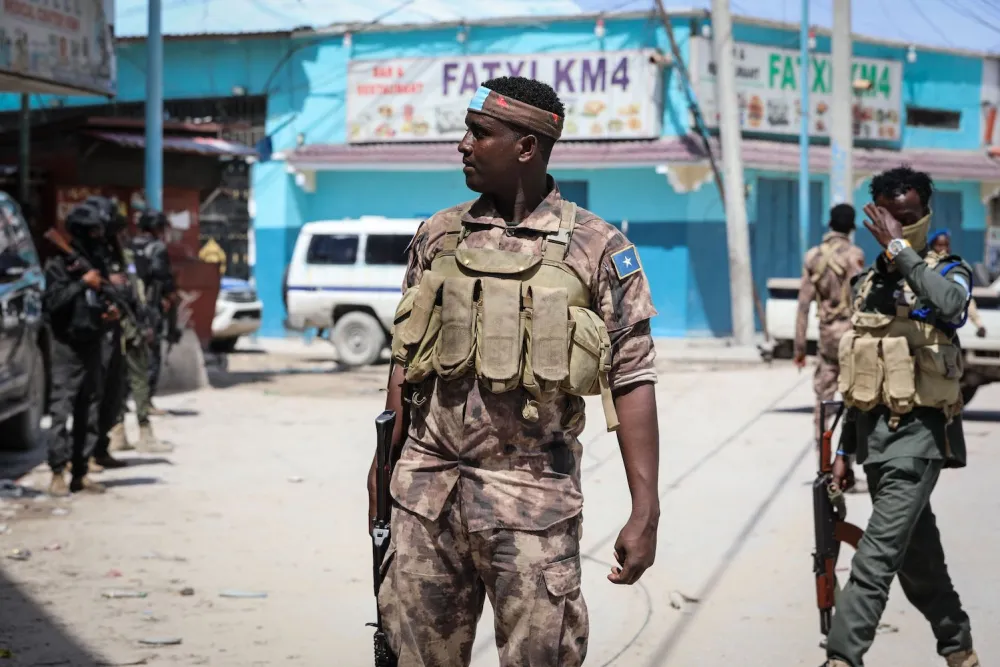In 2025, Somalia faces a growing crisis in its security landscape amid insufficient funding for the African Union’s peace mission, coupled with the United States’ reluctance to support new funding models.
These developments are creating opportunities for Al-Shabab to exploit weak points in Somalia’s defense and are dealing a serious blow to the Somali government’s stability efforts.
What Is AUSSOM — and Why Funding Cuts Matters
On January 1, 2025, the African Union Support and Stabilization Mission in Somalia (AUSSOM) officially replaced the previous mission, ATMIS.
The new mission was designed as a transitional peacekeeping operation tasked with supporting Somali forces, combating Al-Shabab, and helping the country achieve sustainable security.
AUSSOM funding was intended to follow a hybrid model under UN Security Council Resolution 2719.
With about 75% of mission costs covered by UN-assessed contributions and the remaining 25% raised by the African Union and international partners.
Only $14.5 million Secured
However, this structure quickly encountered problems.
$41.6 million were needed but only $14.5 million has been secured so far.
This leaves an alarming $27 million gap.
The funding cuts threaten the mission’s operational capabilities, including troop salaries, logistics, and essential supplies needed for on-ground security operations.
Read also: American President Donald Trump Bullies Somalia – Will This Break Somalia-US Trust
The U.S. Position and Its Impact
The United States has publicly declined to support the hybrid funding model, citing concerns about financial accountability and transparency.
Washington argues that UN-assessed contributions might end up covering more than 90% of the mission’s costs “far above the intended limit”.
Because of this position, AUSSOM funding pipeline remains fragile.
Both the Somali government and the African Union have called on other donors to step in and fill the gap. Without immediate support, peacekeeping operations risk losing momentum, undermining hard-won progress against Al-Shabab.
Al-Shabab’s Gains and the Consequences
The funding cuts has made a direct impact on the ground.
Analysts have observed that Al-Shabab has been regaining influence in rural areas and small towns that were once under government or AU control.
Reduced operational capacity limits the mission’s ability to conduct counter-terrorism activities and protect liberated territories.
Delays in troop stipends and shortages in logistics have also affected morale within both Somali and AU forces.
Al-Shabaab Growing Confidence
In some cases, local forces are unable to respond quickly to militant attacks, allowing Al-Shabab to strengthen its foothold and expand its propaganda efforts.
The group’s growing confidence poses a wider threat to national stability and regional security.
If the funding cuts crisis continues, Al-Shabab could consolidate control in strategic areas, potentially disrupting trade routes and humanitarian access.
Broader Implications of Funding Cuts on Somalia and the Region
Somalia’s government cannot afford to lose more ground.
The country has made significant security gains in recent years through coordinated military operations and international support.
A regression would not only embolden Al-Shabab but also erode public trust in state institutions.
The instability also carries humanitarian consequences.
What Are the Humanitarian Consequences of Instability in Somalia?
Increased displacement, interrupted access to aid, and worsening food insecurity could follow if peacekeeping forces are forced to scale down operations.
With over four million Somalis already in need of humanitarian assistance, any decline in security would deepen the crisis.
Regional stability is also at stake.
A weakened Somalia could destabilize neighboring countries such as Kenya and Ethiopia, both of which have faced cross-border militant attacks.
The Horn of Africa’s strategic location near the Red Sea and Indian Ocean makes it an area of global security interest, further underlining the need for continued international commitment.
The Way Forward
Experts recommend several urgent steps to stabilize the situation:
- Filling the funding gap immediately: Securing the remaining $27 million is essential for AUSSOM to maintain operations.
- Diversifying donor support: Engaging Gulf states, European partners, and international organizations can reduce over-reliance on a few donors.
- Improving transparency: Stronger financial oversight would address donor concerns and encourage renewed participation from countries like the U.S.
- Empowering Somali forces: Long-term stability depends on building capable, self-reliant national security institutions.
US Funding Cuts Risk Years of Progress
The U.S. funding cuts and rejection of AUSSOM’s hybrid financing model are more than budgetary issues. They mark a defining moment for Somalia’s future.
As Al-Shabab regains momentum and regional uncertainty grows, Somalia’s government faces the difficult task of sustaining peace with limited resources.
Unless global partners step up to fill the gap, years of progress risk being undone, threatening not only Somalia’s security but the entire Horn of Africa’s stability.


